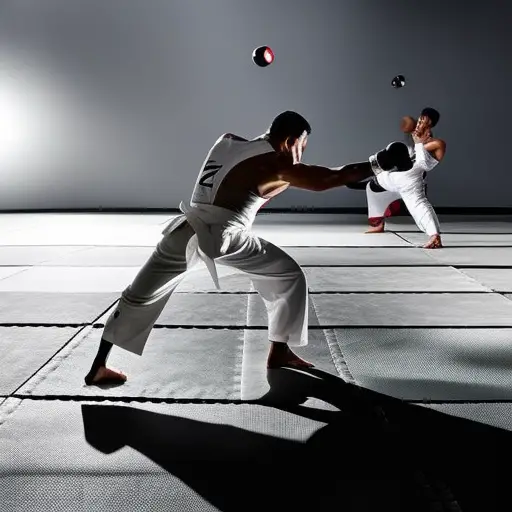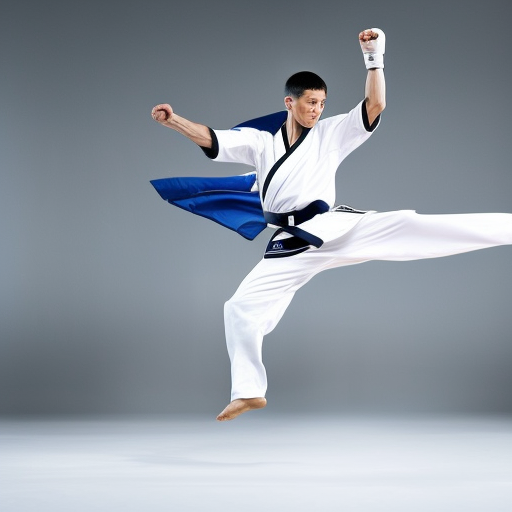The Progression From White Belt to Black Belt

Did you know that less than 1% of individuals who start learning martial arts reach the prestigious rank of black belt?
The journey from white belt to black belt is a testament to dedication, discipline, and perseverance. This article explores the progression through the various belt levels, from mastering the basics as a white belt to pushing the limits as an advanced practitioner.
Join us as we delve into the path towards black belt excellence in martial arts.
The Basics: Starting Out as a White Belt
One of the fundamental aspects of a white belt’s journey in martial arts is the development of their own unique fighting style. As a beginner, white belts are introduced to the fundamental techniques that serve as the building blocks for their future progress. These techniques, such as punches, kicks, blocks, and stances, provide a solid foundation upon which the white belt can develop their skills.
However, it is not just about learning the techniques themselves; it is also about cultivating the right training mindset. White belts are encouraged to approach their training with discipline, determination, and an eagerness to learn. They must understand that progress in martial arts is a gradual process and that it requires consistent effort and practice.
White belts are often reminded to focus on the basics and to master them before moving on to more advanced techniques. This emphasis on mastering the fundamentals is crucial as it ensures that the white belt is building a strong and solid foundation for their future growth.
Building a Strong Foundation: Advancing Through the Ranks
As white belts progress through their training, they must consistently demonstrate their mastery of foundational techniques in order to advance to higher ranks. Understanding the belt promotion criteria is crucial for their progression. Each martial arts discipline has its own set of requirements for belt promotion, which typically include a combination of technical proficiency, knowledge of forms or patterns, sparring ability, and a demonstration of character traits such as discipline, respect, and perseverance. It is essential for white belts to familiarize themselves with these criteria and work towards meeting them.
Consistency plays a vital role in advancing through the ranks. White belts must maintain progress and continue to improve their skills in order to earn higher belts. This requires regular practice and dedication to their training. Attending classes consistently, practicing outside of class, and seeking guidance from instructors are key steps towards building a strong foundation. Without consistency, it becomes difficult to demonstrate the necessary growth and development required for promotion.
Advancing through the ranks is not solely about technical proficiency but also about personal growth and character development. White belts must strive to embody the values of their martial arts discipline and consistently demonstrate these qualities throughout their journey. By understanding the belt promotion criteria and maintaining consistency, white belts can build a strong foundation and progress towards their ultimate goal of achieving a black belt.
Mastering Techniques: Progressing to Intermediate Levels
Significantly, in order to advance to intermediate levels, practitioners must not only demonstrate technical proficiency, but also a deep understanding and application of martial arts techniques. At this stage, practitioners have already built a strong foundation and are now ready to delve into more advanced strategies and techniques.
One crucial aspect of progressing to intermediate levels is the development of advanced strategies. This involves learning how to anticipate and react to different situations, as well as understanding the strengths and weaknesses of both oneself and opponents. Advanced strategies require practitioners to think strategically, analyzing their opponents’ movements and finding ways to exploit their vulnerabilities.
In addition to advanced strategies, training intensity also plays a vital role in progressing to intermediate levels. Practitioners must increase the intensity of their training sessions to build endurance, strength, and speed. This can be achieved through various methods such as interval training, sparring, and incorporating high-intensity drills into their training routine. By pushing themselves to their limits, practitioners can improve their overall physical fitness and enhance their martial arts skills.
Pushing Limits: Reaching Advanced Belt Levels
To truly reach advanced belt levels in martial arts, practitioners must continuously challenge themselves both mentally and physically, pushing beyond their comfort zones and striving for excellence. The journey to advanced belt levels requires a deep commitment and a willingness to embrace the difficulties that come with it.
Here are three key elements that contribute to reaching advanced belt levels:
-
Mental resilience: Overcoming challenges in belt progression requires a strong mindset. Practitioners must learn to push through self-doubt, fear, and frustration. They must develop the ability to stay focused and motivated even in the face of setbacks. Mental resilience is crucial for mastering complex techniques and strategies, as well as for maintaining a positive attitude throughout the journey.
-
Physical conditioning: The importance of strength and flexibility cannot be understated in advanced belt levels. Practitioners must develop a high level of physical fitness to perform advanced techniques with precision and power. Regular strength training, cardiovascular exercises, and flexibility training are essential to improve overall physical performance and reduce the risk of injuries.
-
Consistent practice: Reaching advanced belt levels requires consistent and dedicated practice. Practitioners must commit to regular training sessions, focusing on refining their techniques and expanding their knowledge. Consistency is key to building muscle memory and deepening understanding of martial arts principles.
The Ultimate Achievement: Reaching Black Belt Excellence
Reaching black belt excellence is the culmination of years of dedication, discipline, and perseverance in the practice of martial arts. It represents the highest level of achievement and mastery in the art form. Beyond physical prowess, black belt excellence is also about mental discipline and cultivating inner strength.
Martial arts training goes beyond the physical aspect of combat. It requires a deep commitment to personal growth and self-improvement. The mental discipline developed through years of training helps practitioners overcome challenges, both on and off the mat. It teaches them to be resilient, focused, and determined in the face of adversity.
Moreover, reaching black belt excellence also means embracing the black belt mindset, which encompasses leadership and responsibility. Black belts are expected to not only excel in their own practice but also to inspire and guide others. They become role models within the martial arts community, leading by example and setting high standards for others to follow.
Leadership and responsibility go hand in hand with black belt excellence. Black belts are entrusted with the task of passing on their knowledge and experience to the next generation of martial artists. They become mentors, guiding and supporting their students in their own journeys towards excellence.
Frequently Asked Questions
How Long Does It Typically Take to Progress From a White Belt to a Black Belt?
The average time it takes to progress from a white belt to a black belt varies depending on several key factors, such as the individual’s dedication, training intensity, and natural ability.
Are There Any Age Restrictions for Advancing Through the Ranks and Reaching Higher Belt Levels?
Age restrictions for advancing through the ranks and reaching higher belt levels vary depending on the martial arts school or organization. Some schools may have minimum age requirements to ensure participants can safely meet physical demands and comprehend the training.
Can Someone With Physical Limitations or Disabilities Still Progress and Achieve a Black Belt?
Individuals with physical limitations or disabilities can still progress and achieve a black belt through training adaptations. The path requires a strong mindset and determination to overcome physical challenges, highlighting the importance of resilience and perseverance in martial arts.
Is It Necessary to Compete in Tournaments or Attend Seminars to Reach Advanced Belt Levels?
In the progression from white belt to black belt, alternative paths exist for reaching advanced belt levels without the need to compete in tournaments or attend seminars. Self-training plays a crucial role in this journey.
Are There Any Specific Martial Arts Styles or Disciplines That Are More Conducive to Progressing From a White Belt to a Black Belt?
When it comes to the progression from white belt to black belt, certain martial arts styles or disciplines can be more effective. However, it is essential to emphasize the importance of mindset and dedication in advancing through the belt levels.
Conclusion
In conclusion, the journey from a white belt to a black belt is a testament to one’s dedication and perseverance. It requires building a strong foundation, mastering techniques, and pushing limits to reach advanced levels.
The ultimate achievement of obtaining a black belt signifies excellence and a deep understanding of martial arts. It is a journey that is not to be taken lightly but is worth every ounce of effort.
So, embrace the irony of starting as a beginner and revel in the satisfaction of becoming a true martial arts master.





